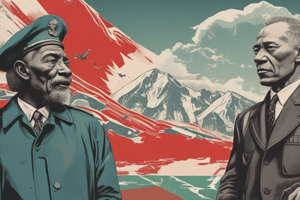Podcast
Questions and Answers
What event marked the official dissolution of the Soviet Union?
What event marked the official dissolution of the Soviet Union?
- December 26, 1991 (correct)
- Fall of the Berlin Wall
- Chernobyl Disaster
- August Coup
Glasnost was a policy introduced to promote secrecy in the government.
Glasnost was a policy introduced to promote secrecy in the government.
False (B)
Name one key factor that contributed to the economic troubles of the USSR.
Name one key factor that contributed to the economic troubles of the USSR.
Stagnation of the economy or decline in oil prices
The _______ Coup was an attempted coup against Mikhail Gorbachev in 1991.
The _______ Coup was an attempted coup against Mikhail Gorbachev in 1991.
Match the events with their significance:
Match the events with their significance:
Which of the following best describes Perestroika?
Which of the following best describes Perestroika?
The rise of nationalist sentiments in the Soviet republics contributed to the stability of the USSR.
The rise of nationalist sentiments in the Soviet republics contributed to the stability of the USSR.
What major external conflict drained Soviet resources during the Cold War?
What major external conflict drained Soviet resources during the Cold War?
The decline in oil prices during the 1980s intensified the USSR's economic _______.
The decline in oil prices during the 1980s intensified the USSR's economic _______.
What was a direct consequence of the policies of Glasnost and Perestroika?
What was a direct consequence of the policies of Glasnost and Perestroika?
Flashcards are hidden until you start studying
Study Notes
Overview of the Collapse of the USSR
- Timeline: The Soviet Union officially dissolved on December 26, 1991, but the events leading to its collapse unfolded throughout the late 1980s.
Key Factors Leading to the Collapse
-
Economic Issues:
- Stagnation of the economy: Inefficiencies in central planning led to shortages and poor quality of goods.
- Decline in oil prices: The USSR's economy heavily relied on oil exports; the 1980s oil price drop exacerbated economic troubles.
-
Political Reforms:
- Glasnost (Openness): Introduced by Mikhail Gorbachev in 1986, aimed at transparency and freedom of expression but led to public criticism of the government.
- Perestroika (Restructuring): Gorbachev's economic reforms failed to revive the economy and resulted in increased dissatisfaction.
-
Nationalism and Independence Movements:
- Rise of nationalist sentiments in various Soviet republics: Ethnic groups sought independence, leading to political instability.
- Key republics like Lithuania, Ukraine, and Georgia declared independence, weakening the central authority.
-
Cold War Dynamics:
- Ongoing arms race and economic competition with the West strained resources.
- The failed invasion of Afghanistan (1979-1989) drained military, economic, and political capital.
-
Social Unrest:
- Widespread protests and strikes across various industries due to economic hardships and political repression.
- The rise of dissident movements advocating for democracy and reform.
Significant Events
- Chernobyl Disaster (1986): Nuclear accident that highlighted governmental inadequacies and fueled public discontent.
- Fall of the Berlin Wall (1989): Symbolized the decline of communist regimes in Eastern Europe and inspired independence movements in the USSR.
- August Coup (1991): Attempted coup by hardliners against Gorbachev that failed, leading to increased power for Boris Yeltsin.
Aftermath
- Dissolution of the Soviet Union: Officially dissolved in December 1991, resulting in the emergence of 15 independent republics.
- Transition to Market Economy: Many former Soviet states transitioned to market economies, often facing significant challenges.
- Geopolitical Changes: The collapse shifted global power dynamics, leading to the U.S. as the sole superpower and various regional conflicts arising from ethnic tensions.
Conclusion
The collapse of the USSR was a complex interplay of economic stagnation, political reform, rising nationalism, and social unrest, culminating in significant global changes.
Overview of the Collapse of the USSR
- Official dissolution date: December 26, 1991; events leading up began in the late 1980s.
Key Factors Leading to the Collapse
- Economic stagnation due to inefficiencies in central planning resulted in shortages and low-quality goods.
- A significant decline in oil prices in the 1980s adversely affected the Soviet economy, which heavily relied on oil exports.
- Mikhail Gorbachev introduced Glastnost (1986) to promote transparency and expression, leading to increased public criticism of the government.
- Gorbachev's Perestroika aimed to restructure the economy, but failed to revive it, creating further dissatisfaction among citizens.
- Nationalist sentiments surged across various Soviet republics, with key areas like Lithuania, Ukraine, and Georgia declaring independence, undermining central authority.
- The Cold War's arms race and competition with the West strained the USSR's economic resources.
- The failed invasion of Afghanistan (1979-1989) drained the USSR's military and political capital.
- Widespread protests and strikes emerged as citizens faced economic hardships and political repression.
- Dissident movements gained traction, advocating for democracy and reform.
Significant Events
- The Chernobyl disaster in 1986 showcased governmental failures, increasing public discontent.
- The fall of the Berlin Wall in 1989 represented the decline of communist power in Eastern Europe, inspiring independence movements within the USSR.
- The August Coup of 1991, an unsuccessful attempt by hardline elements against Gorbachev, strengthened Boris Yeltsin's position.
Aftermath
- The Soviet Union's dissolution led to the establishment of 15 independent republics.
- Many former Soviet states faced challenges transitioning to market economies post-collapse.
- The geopolitical landscape shifted significantly, resulting in the U.S. emerging as the sole superpower and ethnic tensions causing various regional conflicts.
Conclusion
- The USSR's collapse stemmed from a combination of economic stagnation, political reforms, nationalism, and social unrest, resulting in major global shifts.
Studying That Suits You
Use AI to generate personalized quizzes and flashcards to suit your learning preferences.




